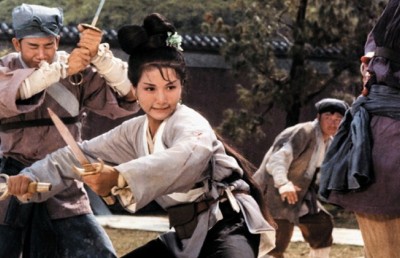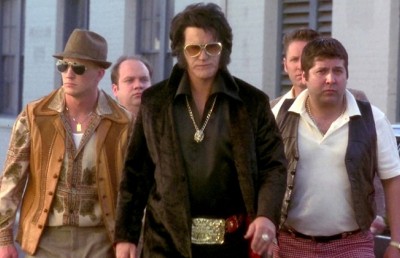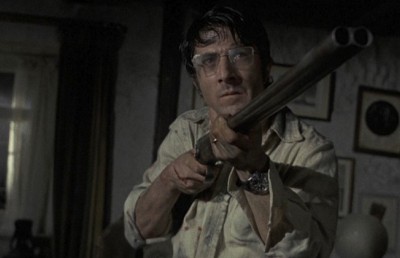28 Days Later
The fine line between homage and imitation
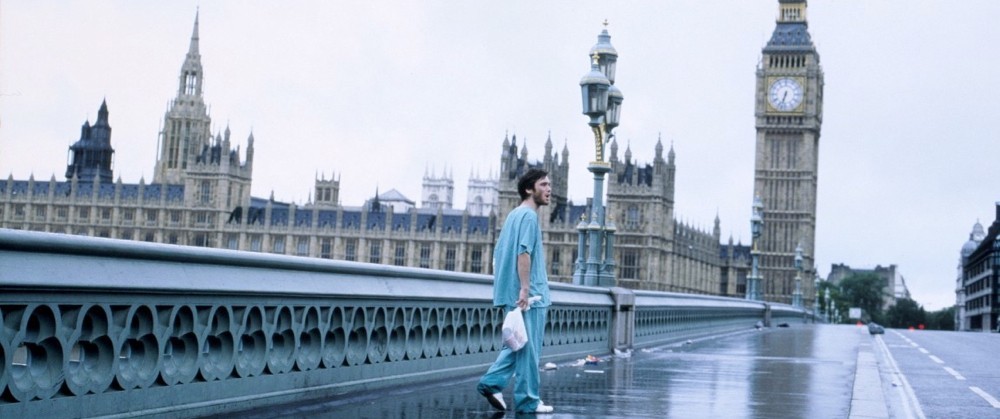
Sometimes it is a fine line between homage and imitation. With the plentiful allusions to George Romero’s classic zombie trilogy (Night of the Living Dead, 1968, Dawn of the Dead, 1979, and Day of the Dead, 1985) the line is perilously treaded in Danny Boyle’s latest pseudo zombie, science-fiction action thriller 28 Days Later. The UK film has hit North American screens with a blizzard of promotional hype. The trailers I had seen made the film out to be a terrifying zombie film of the 1970’s ilk, only with faster moving zombies replacing the lumbering undead seen in Romero’s films and the countless Italian zombie films of the 1970s (although it must be said that Boyle did not invent the fast moving zombie either, since Umberto Lenzi featured them in his 1980 Nightmare City, aka City of the Walking Dead). Although the film has its moments, it failed to deliver the dread and horror usually associated with the time honored zombie film that was promised in the trailers (not that the filmmaker has anything to do with the trailer). In fact I would add, and this may be merely a semantic sticking point for some, that the film is not really a zombie film because the humans causing havoc have not died and come back to life. Rather they are ‘infected’ with an unknown virus that started in a laboratory. Granted other zombie films have also had ecological and environmental reasons for the zombie contagion (The Living Dead at Manchester Morgue, aka Let Sleeping Corpses Die, Jorge Grau, 1974, Nightmare City, aka City of the Walking Dead, Umberto Lenzi, 1980, and Night of the Zombies, aka Cannibal Virus, aka Zombie Creeping Flesh, Bruno Mattei, 1980), but the infected usually die and/or are cannibalized before coming back to life. This may seem like a minor point, but the fact of having someone die and come back to life adds immeasurable social and allegorical weight to the zombie film iconography (namely Freud’s ‘uncanny’, the return of the repressed, religious apocalyptical imagery, and voodoo/black magic mythology). Although Boyle does, to his credit, layer the film’s actions and scenarios with some social and political subtext that strengthens the film’s humanism, namely the conduct of the military, it lacks the metaphysical possibilities associated with the former.
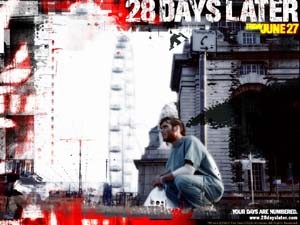
The film opens in a science laboratory where we see several chimpanzees in cages. Three armed and aggressive animal activists enter the laboratory to set the animals free, against the repeated frantic warnings of a scientist. An activist opens a cage and a manic chimpanzee jumps out and attacks her, setting off the fatal virus. The image fades to black, foreboding intertitle which reads “28 days later.” The fact that the activists take no heed whatsoever of what the scientist was saying, or his state of panic, says something about human nature which shapes the film’s central thematic: humans are dangerous and single-minded in their personal drives regardless of whether they are ‘infected’ or ‘healthy.’ And as the film progresses, we come to learn that each adult character in the film is driven in a similar, single-minded, and in some cases selfish, manner.
The narrative proper begins after the title card. A young man, Jim (Cillian Murphy), wakes up from a coma inflicted, we later learn, from an injury sustained in a bicycle accident. To his confusion, the hospital is empty and in a disheveled state. He is met with a similar scenario as he walks through a desolate London. The Rip Van Winkle-like character soon learns of the virus that has separated London into the ragingly mad and violent infected and the few remaining humans trying to stay one step ahead of the infected. Jim is ambushed by an infected ‘zombie’ but saved by a black woman, Selena (Naomie Harris), and a young man, Mark (Noah Huntley), who becomes infected in the rescue mission. In this scene we learn that once infected, a human has all but about 20 seconds before they turn rabid. Selena takes the appropriate action and machete’s Mark to death before he can turn on them. When the shocked Jim asks Selena how she could have been so sure that he was infected, she replies, “I didn’t, but I could see in his eyes that he knew” (quote is paraphrased). Survival lesson number one for Jim. They meet up with two other humans living in a high-rise apartment, a middle-aged man named Frank (Brendan Gleeson) and his teenager daughter Hannah (Megan Burns). The group hears a pre-recorded radio message from the military of a safety zone in North Manchester where the military claim to have the ‘solution to the virus.’ From this point on the film becomes a road movie with the surrogate family bonding as they test their survival skills (and have some fun) on route to the military camp. Once there the film moves toward its central plot twist (MAJOR SPOILER): the message was a ploy by the military to get women into their compound so they can begin the repopulation of England. The bizarre plan is a result of Major West’s (Christopher Eccleston) theory that the rest of the world has ‘quarantined’ England until all the infected people die out. The soldiers buy into his plan and become as ravenous as the infected, fighting each other to see who will rape the victims first. Keep in mind that one of the victims, Hannah, is about fourteen years of age. This thematic point of humanity being potentially vile and murderous, infected or otherwise, is hammered home in the script Major West’s dialogue on how humans have killed 28 days before the virus and will continue to do so 28 days after and once again near the end when Jim rescues the captive women by gruesomely murdering a soldier with his bare hands. It’s a nice touch that this killing of a human by a human is the most violent and explicit in the film (Jim gouges his thumbs deep into the soldier’s eye sockets). This plot twist of having a double-edged assault (the infected and the military), like just about everything else in 28 Days Later, is derived from previous zombie film convention (think the zombies and the posse in Night of the Living Dead, the bikers and the zombies in Dawn of the Dead, the zombies and the native cannibals in Zombie Holocaust 1979, Marino Girolami).
I was not surprised when I read that Boyle does not consider his film a horror film. It is another case of the flexibility and double-edged nature of genre: the marketing team is clearly pushing this as a horror film, while the director has made a hybrid film, part zombie film, part virus film (The Crazies, George Romero,1973, Shivers, David Cronenberg, 1975, Blue Sunshine, Jeff Lieberman, 1977, Virus, Kinji Fukasaku, 1980, Outbreak, Wolfgang Petersen, 1995), and part last-human-on-earth film (The World, the Flesh and the Devil, Ranald MacDougall, 1959, The Last Man on Earth, Sidney Salkow, 1964, The Omega Man, Boris Sagal, 1971). All of these elements have already, of course, been worked together across the filmography of George Romero, namely through The Crazies and his zombie trilogy, not to mention the psychotic chimpanzee from Monkey Shines. But it is best not to compare this to Romero, since the latter’s work is head and shoulders above what Boyle has done here.
In a recent interview Romero had this to say, “Nobody would presume to go out and make a comedy but everybody out there thinks they know how to make a horror film” (Rue Morgue, July/August 2003, p. 20). Given the deft handling of suspense in Shallow Grave, I would not go so far as saying that this is a case of a director being wholly out of their element, but clearly Boyle did not feel comfortable working within the confines and tradition of the horror film, or simply was not interested in such an approach (and I’m not buying the postmodern, pastiche theory cop-out). As a strategy, this may make a film more successful at the box-office, but not without consequences. The most damning, for a film with pretenses of horror, is that it does not maintain a level of fear associated with horror. The moments of horror are treated more as an intervention into the proceedings rather than an element which grows slowly out of the dread and misery of the situation. Stylistically the film works against horror film aesthetics. Most of the ‘zombie’ attacks occur too quickly, without a proper build-up, and without any lingering moments after the attacks. Gore and the gross-out scenes may not be a pre-requisite of the horror film, but it sure helps up the ante, especially when nothing else works. The attacks occur so fast and are edited so quickly that we never even get to see what the infected humans do to their victims! And when not being fragmented with rapid fire edits, the infected are shot with a step printed stuttering camera movement that has become an annoyingly overused visual effect in recent horror films. Even the wonderful mood in the opening scene of Jim walking through an empty London cityscape is marred by an overbearing rock soundtrack that builds to a chaotic crescendo. Apparently the film was shot on digital video for both aesthetic (grittier) and economic reasons. However, the film’s style leads me to believe the latter is the real reason, because if the notion of a gritty, realistic style was so important to Boyle he would not have subverted this design with overbearing music and gimmicky visual effects.
I am not saying that a horror film has to go for the jugular full-throttle. A horror film can often benefit from a reprieve, and in fact my favorite moment in 28 Days Later is not one of the “horror” scenes but the quiet picnic scene by the river where the surrogate ‘family’ cements the bonding process. The (Tarkovskian?) image of the horses galloping next to the lake, beautifully underscored by Brian Eno’s transcendent track “The Ascent,” renders a powerful sense of nature in harmony that contrasts with the human made chaos and strikes an environmental political chord. Therefore horror, fear, and dread need not dominate every moment in a horror film, but it must be the driving force, and it clearly isn’t in 28 Days Later.
Even among those who enjoy the film, there is a consensus that the ending is flawed, mainly because of the dramatic shift in tone from the intense action of the military scenes to the final scene of the three survivors, Jim, Selena, and Hannah, living in Swiss Family Robinson-like harmony, not seeming too worried about whether or not the overhead jet has seen their huge “Hello” sign. Frankly, aside from the noted shortcomings in terms of pure fright, the film has problems long before the ending with its many unanswered questions: if London is in total anarchy, where are all the bodies in the opening scenes of Jim walking through London? Yes later we do see neat piles of dead bodies along the side of the road, but it seems unlikely that such order would continue given the state of anarchy. Major West’s conspiracy theory of a world-wide quarantine on England may have tossed the military for a psychological loop, but are we really to believe that fully trained military men would turn into raving rapists after not having sex for 28 days? There may be a sense of urgency with regards repopulation, but if the Major’s theory were right, wouldn’t the ‘rest of the world’ eventually lift the quarantine once the threat was over and help to restore the human population balance in England? With regards to the plan to ‘starve’ the infected out, wouldn’t the infected turn on themselves in that scenario (which would only prolong the inevitable)?
Although the film loses some of its tightness and focus once they arrive at the military base, this part of the scenario does offer some social-political reverberation. The film begins with some harrowing actual newsreel footage of recent war atrocities, which subtly sets up the representation of the fictional military long before we see them. Within the context of the newsreel footage (and recent military history), the attempted rape by the soldiers of Hannah and Selena can be seen as a not-so-veiled reference to the Bosnian War crimes of 1992, which recently saw three soldiers convicted by an International Criminal Tribunal for the rape of several Muslim women.
Even though its faults outweigh its strengths, I would recommend 28 Days Later to horror fans. Evidently the surprise box-office success of 28 Days Later has helped George Romero finally put together the finances for a fourth film in his zombie installment, tentatively titled Dead Reckoning. If this ends up being true, for this alone I’d give my blessings to 28 Days Later!



